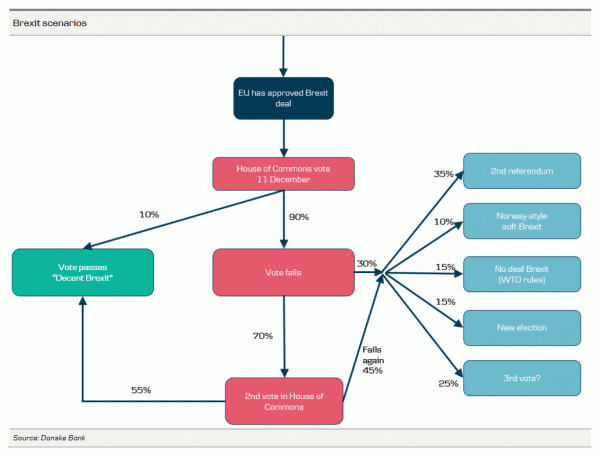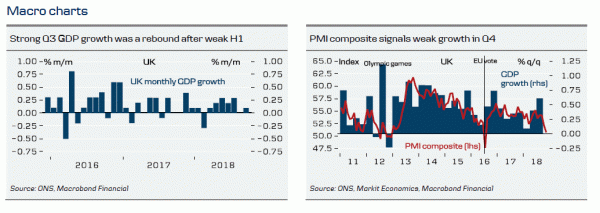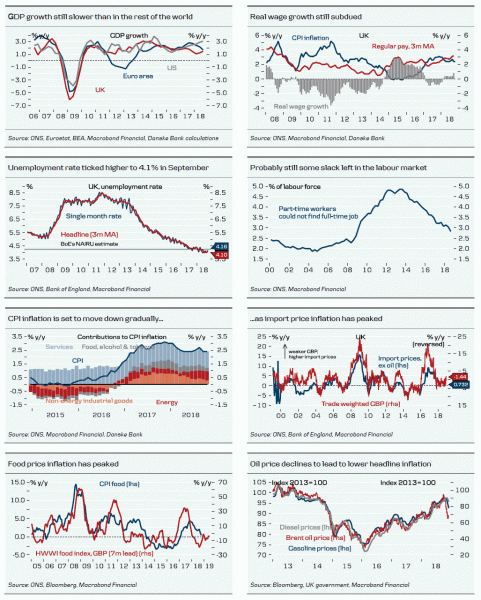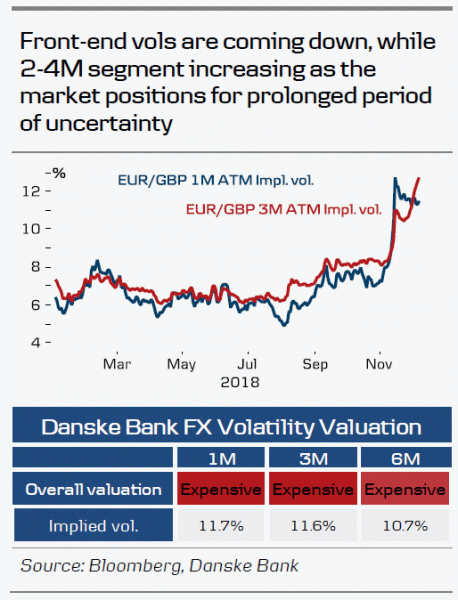Key dates
- 10 December: ECJ ruling on Brexit reversal and 4th day of Brexit debate. 11 December: Vote in House of Commons on Theresa May’s Brexit deal.
- 13-14 December: EU summit. 20 December to 7 January: House of Commons recess due to Christmas
The vote on PM Theresa May’s Brexit deal takes place on Tuesday, 11 December at 20:00 CET (including votes on amendments). Despite May’s attempt to secure public and political backing, it seems unlikely the deal will be passed. According to The Guardian’s count, more than 400 MPs have said they will vote against the deal (320 votes are needed for it to fail). Slightly more than 100 Conservative MPs (a mix of hardliners, soft Brexiteers and pro-EU), May’s supporting party DUP from Northern Ireland, Labour, LibDems and the Scottish National Party appear to be voting against the deal. Only Conservative loyalists and those on the government payroll have indicated they will vote in favour.
What happens if/when the deal is voted down? As a defeat is widely expected, markets would react to the size of the defeat, although we doubt the market reaction will be significant, as political uncertainty is likely to remain elevated. We will monitor the following days to see how the different politicians and groups react. PM May is set to participate in the EU summit beginning on Thursday, 13 December, which will be her first chance to talk face-to-face with the other EU leaders about how to proceed.
Many political analysts say it is likely that PM May will try to hold a second vote in the House of Commons at a later stage. Some have said this could come as early as just before Christmas, but we think January seems more realistic, as she would probably need to secure some concessions from the EU in renegotiations (although they would likely be small, as it is difficult to see what changes the EU would accept at this point). This would require more talks with the EU’s chief negotiator, Michel Barnier, and not only talks with the EU leaders. Given that many appear to expect a second vote, this also makes it easier to vote against the deal the first time, to show opposition without any major consequences. Some Conservative policymakers have urged May to postpone the vote.
What happens if the deal is voted down a second time? Well, then we are in uncharted territory. We think it is difficult to see how PM May could survive two defeats, and would expect her to either resign or be forced out. That opens up a range of possible outcomes. Although we still cannot rule out a ‘no deal Brexit’, we think the likelihood of this scenario has declined after Conservative MP Dominic Grieve’s amendment passed this week, which gives Parliament the possibility to tie the government’s hands in the negotiations. One of the main issues with Brexit is that none of the politicians agree on how the ideal Brexit should look, but the majority definitely wants to avoid a no deal Brexit and the amendment makes it easier for Parliament to avoid that scenario. While the amendment was a short-term defeat for May, as it underlines her lack of power despite being the Prime Minister, it may be positive for her in the long run. At least, it seems to make her threat that it is “her deal or a soft Brexit (or no Brexit at all)” more credible. May’s deal is probably the hardest version of Brexit on the table right now, which is positive, as it is what we call a “decent Brexit”. It also increases the chance that the hardliners will vote for the deal the second time, as they risk a softer Brexit or a reversal of Brexit by voting it down. The deal is clearly not perfect for them but after all the UK would still be able to end free movement of labour and would get an independent trade policy over time. The problem is that the DUP has said it will vote for no confidence in the government if the deal passes, see Tim Shipman (Political Editor on Sunday Times) on Twitter
The probability of a second referendum has increased over the past couple of months. It has probably been made easier by the European Court of Justice, which has said that the UK may be able to withdraw its Article 50 notification (which started the two years of negotiations with the EU) unilaterally as long as the UK is not abusing the rule just to buy more time (however, look out for the final ruling on Monday morning at 09:00 CET). It would still require a majority of Parliament to call a referendum, which will be difficult. Opinion polls suggest the result would be a slim victory for the remain camp.
Recently, a Norway-style option has gathered more attention. This would be a soft Brexit, something that we ruled out as unlikely some time ago. In a Norway-style Brexit, the UK would leave the EU but join both EFTA and EEA (EFTA membership is necessary for EEA membership). While there would not be any economic consequences, the political damages would be significant, as the UK would be subject to all EU laws (including paying to the EU budget and accepting free movement of people) without representation in institutions, agencies, etc. In that case, it would make more sense to just stay in the EU and have power over legislation. For that reason, we believe the likelihood of this scenario playing out is low.
We still believe the likelihood of a new election is low. The Prime Minister cannot call for a snap election anymore and this could only occur if (1) the House of Commons voted for no confidence in the government and no new government were formed within two weeks or (2) the House of Commons dissolved itself by a two-thirds majority. It is difficult to see the Conservative MPs having the incentive to support a snap election, as they risk losing their seats (Labour and the Conservative Party are neck-to-neck in the opinion polls). At some point, some Labour MPs could rebel against the party line and vote in favour of May’s deal in order to move on from Brexit, if/when it became clear that a snap election was unlikely.
FX outlook: EUR/GBP volatile for longer, but lower eventually
In our main scenario, we still expect a ‘decent’ Brexit and we maintain the long-held view that EUR/GBP will break lower towards our ‘Brexit-corrected’ MEVA estimate of 0.82, if/when the deal eventually passes in the UK Parliament.
However, given that the Brexit deal will not likely pass in the House of Commons, the vote on 11 December no longer represents a significant ‘digital risk’ for the FX market and GBP. Hence, we see a high risk that Brexit will remain unresolved when we enter 2019, which should keep EUR/GBP in check albeit volatile around the 0.87-0.90 range for a prolonged period. Indeed, we could still see large fluctuations in EUR/GBP after the vote on 11 December, where the initial knee-jerk reaction will depend on the actual vote. However, the biggest move would, in our view, be downward if the Brexit deal, contrary to expectations, is accepted on 11 December.
Due to May’s weak political position and the Parliament increasingly taking control over Brexit, the risk of a ‘no deal Brexit’ has, in our view, declined, while the likelihood of a softer Brexit and no Brexit at all has increased substantially. This implies that the outcome distribution for EUR/GBP is now tilted towards the downside, and while spikes higher cannot be ruled out near term, we see a higher risk of EUR/GBP remaining range-bound and volatile for longer, rather than the cross testing 1.00 in the coming three months. This should eventually weigh on EUR/GBP.
We raise our 1M EUR/GBP forecast to 0.88 (from 0.84 previously) and lift our 3M target to 0.87 (previously 0.83), as the big break lower may not materialise in the coming months. We stress, however, that we see risk skewed to the downside relative to our 3M target in case Brexit is finalised within the next three months. We keep our 6-12M forecast unchanged at 0.83.
FX strategy: Short EUR/GBP via options
Timing a possible break lower in EUR/GBP is very difficult and given the high degree of ‘digital risk’ in the GBP related to Brexit, we prefer to position for GBP appreciation via FX options. We are short EUR/GBP via 1M-4M put calendar spread as one of our FX Top Trades for 2019. The main risk to this trade is that the big break lower in EUR/GBP materialises within the next month, e.g. if the Brexit deal is accepted by the House of Commons on 11 December or if the probability of a second referendum increases significantly.
Hedging GBP income/asset
We recommend hedging GBP income/assets by buying 25-30 delta EUR/GBP call options. Implied volatility (option price) is very expensive, but we judge that the price is fair given the risk of a bounce in EUR/GBP and not least given the downside potential in our main scenario and other GBP positive scenarios such as a new referendum or ‘no Brexit’. Corporate clients could consider hedging the entire 2019 flow via 3-4M call options. Hedges can then subsequently be swapped out to the actual pay dates when Brexit is clarified. The risk to this strategy is that Brexit remains unresolved when the bought options expire, which would then require buying another period of protection.
Hedging GBP expenses
We are approaching the end of the Brexit path, and we recommend clients hedging GBP payables to increase hedge ratios and hedge horizon via FX forwards. Given the risk of a prolonged period of uncertainty and not least the risk of a near-term bounce in the spot, clients could consider hedging via risk reversals (1-3M). 





















